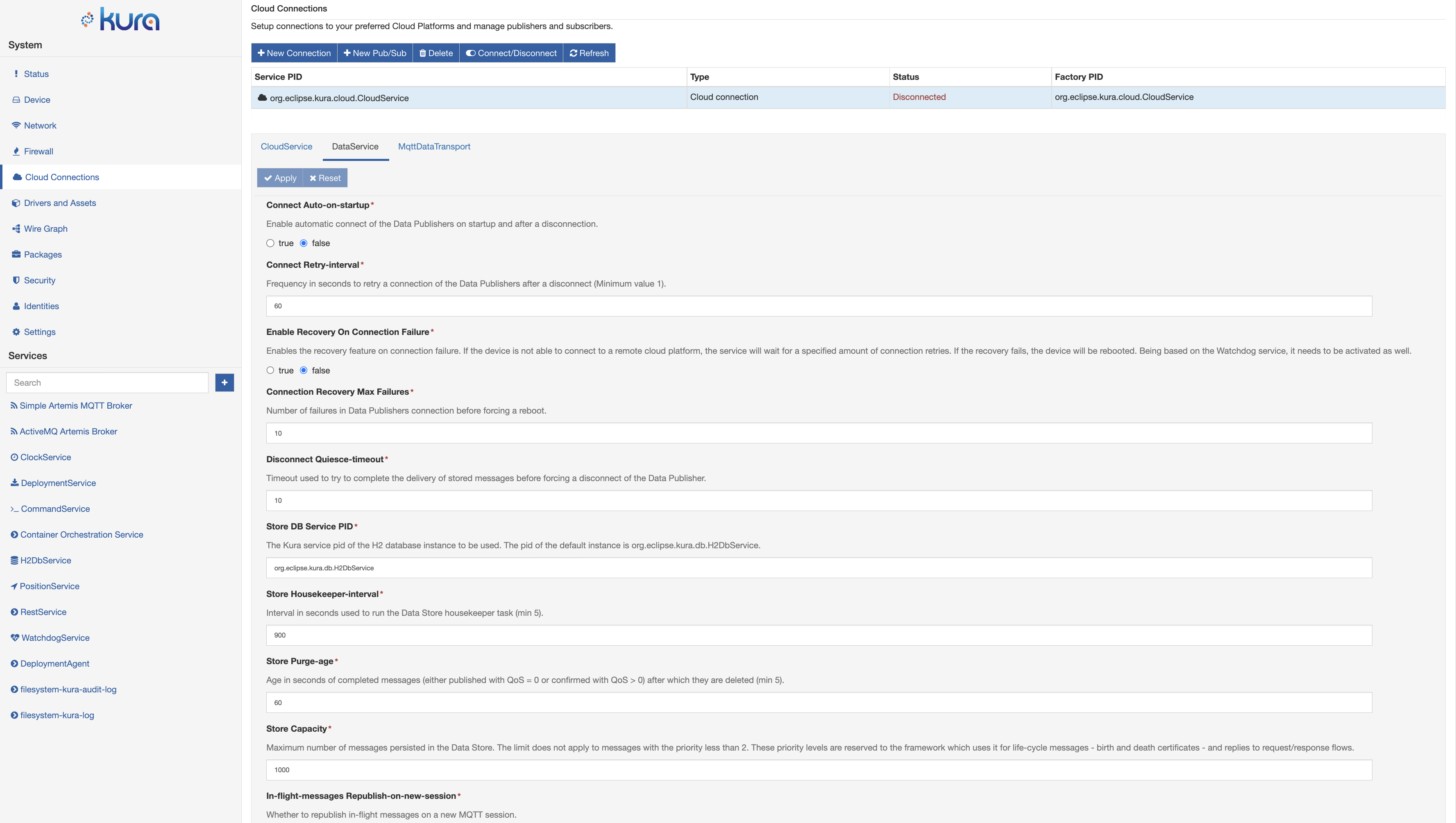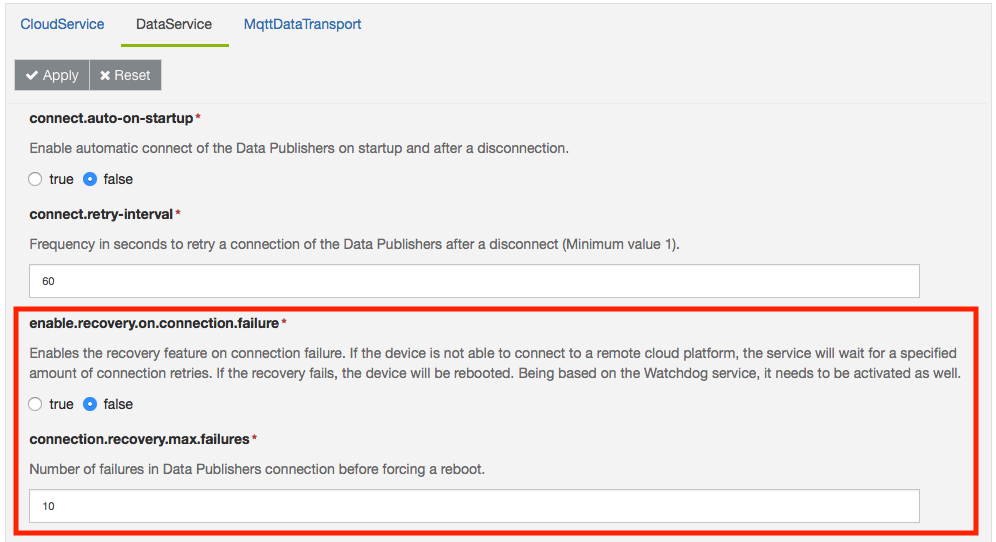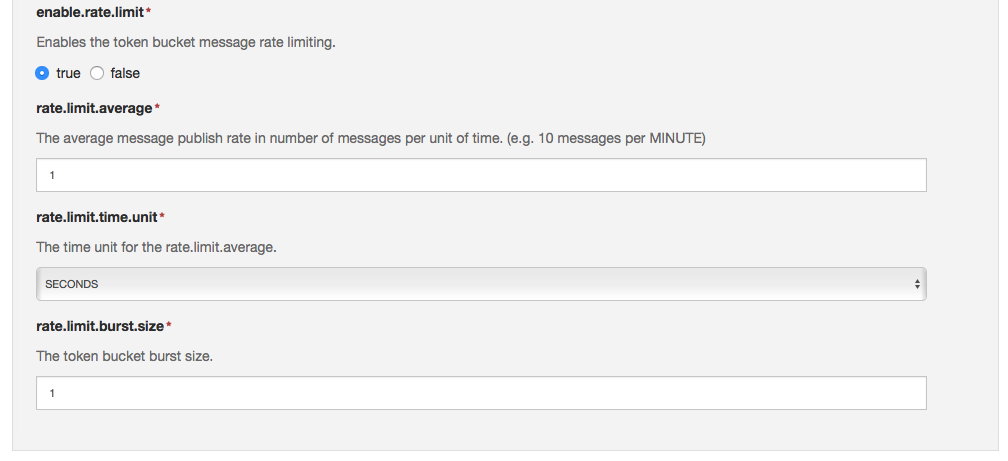Data Service Configuration
The DataService provides the ability to connect to a remote broker, publish messages, subscribe to topics, receive messages on the subscribed topics, and disconnect from the remote message broker. The DataService delegates to the MqttDataTransport service the implementation of the transport protocol that is used to interact with the remote server.
The DataService also adds the capability of storing published messages in a persistent store function and sending them over the wire at a later time. The purpose of this feature is to relieve service users from implementing their own persistent store. Service users may publish messages independently on the DataService connection status.
In order to overcome the potential latencies introduced by buffering messages, the DataService allows a priority level to be assigned to each published message. Depending on the store configuration, there are certain guarantees that stored messages are not lost due to sudden crashes or power outages.
To use this service, select the DataService option located in the Cloud Connections area as shown in the screen capture below.

The DataService offers methods and configuration options to manage the connection to the remote server including the following (all required) parameters described below.
-
connect.auto-on-startup: when set to true, the service tries to auto-connect to the remote server on start-up and restore the connection every time the device is disconnected. These attempts are made at the frequency defined in the connect.retry-interval parameter until the connection is established.
-
connect.retry-interval: specifies the connection retry frequency after a disconnection.
-
enable.recovery.on.connection.failure: when enabled, activates the recovery feature on connection failure: if the device is not able to connect to a remote cloud platform, the service will wait for a specified amount of connection retries. If the recovery fails, the device will be rebooted. Being based on the Watchdog service, it needs to be activated as well.
-
connection.recovery.max.failures: related to the previous parameter. It specifies the number of failures before a reboot is requested.
-
disconnect.quiesce-timeout: allows the delivery of in-flight messages to be completed before disconnecting from the broker when a disconnection from the broker is being forced.
-
store.db.service.pid: The Kura Service PID of the database instance to be used. The PID of the default instance is org.eclipse.kura.db.H2DbService.
-
store.housekeeper-interval: defines the interval in seconds used to run the Data Store housekeeper task.
-
store.purge-age: defines the age in seconds of completed messages (either published with QoS = 0 or confirmed with QoS > 0) after which they are deleted (minimum 5).
-
store.capacity: defines the maximum number of messages persisted in the Data Store.
-
in-flight-messages.republish-on-new-session: it specifies whether to republish in-flight messages on a new MQTT session.
-
in-flight-messages.max-number: it specifies the maximum number of in-flight messages.
-
in-flight-messages.congestion-timeout: timeouts the in-flight messages congestion condition. The service will force a disconnect attempting to reconnect.
-
enable.rate.limit: Enables the token bucket message rate limiting.
-
rate.limit.average: The average message publishing rate. It is intended as the number of messages per unit of time.
Danger
The maximum allowed message rate is 1 message per millisecond, so the following limitations are applied:
- 86400000 per DAY
- 3600000 per HOUR
- 60000 messages per MINUTE
- 1000 messages per SECOND
-
rate.limit.time.unit: The time unit for the rate.limit.average.
-
rate.limit.burst.size: The token bucket burst size.
Connection Monitors
The DataService offers methods and configuration options to monitor the connection to the remote server and, eventually, cause a system reboot to recover from transient network problems.
This feature, if enabled, leverages the watchdog service and reboots the gateway if the maximum number of configured connection attempts has been made.
A reboot is not requested if the connection to the remote broker succeeds but an authentication error, an invalid client id or an authorization error is thrown by the remote cloud platform and causes a connection drop.
The image below shows the parameters that need to be tuned in order to enable this connection monitor feature.

To configure this functionality, the System Administrator needs to specify the following configuration elements:
-
enable.recovery.on.connection.failure: when enabled, activates the recovery feature on connection failure: if the device is not able to connect to a remote cloud platform, the service will wait for a specified amount of connection retries. If the recovery fails, the device will be rebooted. Being based on the Watchdog service, it needs to be activated as well.
-
connection.recovery.max.failures: related to the previous parameter. It specifies the number of failures before a reboot is requested. !!! warning To be fully working, this feature needs the enabling of the Watchdog Service.
Message Publishing Backoff Delay
In order to have a finer control on the data flow, when a device reconnects to a remote cloud platform, Kura integrates into the Data Service a Backoff delay feature that limits the rate of messages sent.
This feature, enabled by default, integrates the Token Bucket concept to limit the bursts of messages sent to a remote cloud platform.
In the image below, the parameters that need to be tuned, in the Data Service, to take advantage of this feature:

-
enable.rate.limit: Enables the token bucket message rate limiting.
-
rate.limit.average: The average message publishing rate. It is intended as the number of messages per unit of time.
-
rate.limit.time.unit: The time unit for the rate.limit.average.
-
rate.limit.burst.size: The token bucket burst size.
The default setup limits the data flow to 1 message per second with a bucket size of 1 token.
Warning
This feature needs to be properly tuned by the System Administrator in order to prevent delays in the remote cloud platform due to messages stacked at the edge.
If not sure of the number of messages that your gateways will try to push to the remote platform, we suggest to disable this feature.